VENTO BY ALBERTO BARAYA – IN PONTEVEDRA
The Museum of Pontevedra exhibits Vento (wind, in Galician), the proposal that the artist Alberto Baraya (Bogota, Colombia, 1968) has developed and now shows at its headquarters in the Castelao Building as part of the cycle of exhibitions Infiltracións. This program aims to carry out specific projects that have as their backbone the dialogue arising from research and work with pieces from the collection of the Galician institution to promote re-readings on it.
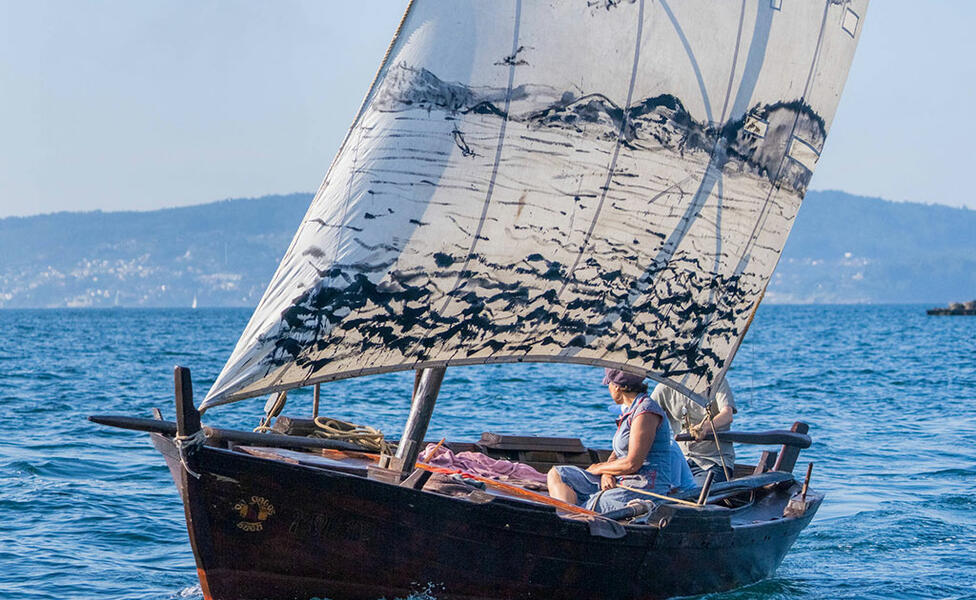
For Vento, Baraya began by drawing inspiration from the reinterpretation of several marine-themed works approached from techniques as disparate as painting, ceramics, cartography or modeling. From these starting points, the Colombian artist traced his project until he ended up with the instrumental use of the ship's sail as a working material and, by the way, endorsed the historical importance of this object in the colonial artistic processes, when these were used as canvases in the New World.
Last summer, Baraya decided to sail in a sailboat along the Pontevedra estuary as part of the action that would lead him to capture in this same sail the environment and the landscape he was contemplating, evolving from the plenairist pictorial and highlighting the techniques of fast painting. The primary result of the activity, the sail as a large canvas, is presented accompanied by a video piece as a documentary record, along with those paintings, drawings and models from the collections of the Museum of Pontevedra that originally inspired this action.
Alberto Baraya. Vento, exhibition part of the Infiltracións program, can be seen until March 2, 2025 at the Castelao Building of the Museum of Pontevedra, Padre Amoedo Carballo, 3, Pontevedra (Spain).
May interest you
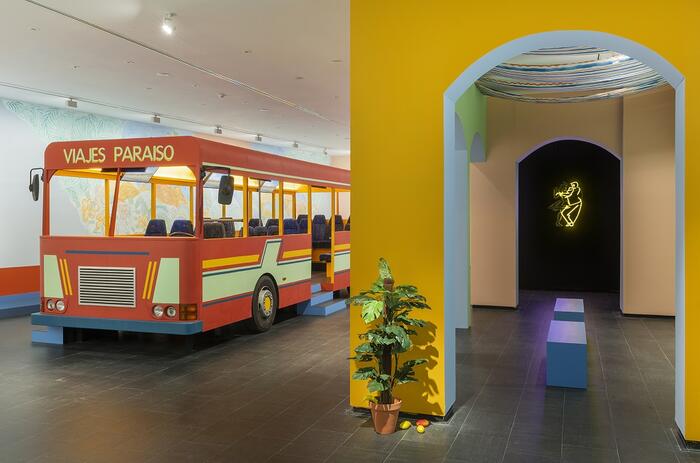
Sol Calero (Caracas, Venezuela, 1982) uses the guanabana, a fruit endemic to Central America and the Caribbean, to symbolically instrumentalize the creation of a representation of the feelings of belonging, home, everyday life and stereotypes through the wide conquest of the spaces of the Museo Centro de Arte Dos de Mayo, transformed for the occasion into visual and popular references of a well-known and recognized Latin America.
IDENTITY AND HOME – ACCORDING TO SOL CALERO IN THE CA2M MUSEUM
Sol Calero (Caracas, Venezuela, 1982) uses the guanabana, a fruit endemic to Central America and the Caribbean, to symbolically instrumentalize the creation of a representation of the feelings of belonging, home, everyday life and stereotypes through the wide conquest of the spaces of the Museo Centro de Arte Dos de Mayo, transformed for the occasion into visual and popular references of a well-known and recognized Latin America.

Sol Calero (Caracas, Venezuela, 1982) uses the guanabana, a fruit endemic to Central America and the Caribbean, to symbolically instrumentalize the creation of a representation of the feelings of belonging, home, everyday life and stereotypes through the wide conquest of the spaces of the Museo Centro de Arte Dos de Mayo, transformed for the occasion into visual and popular references of a well-known and recognized Latin America.
IDENTITY AND HOME – ACCORDING TO SOL CALERO IN THE CA2M MUSEUM
Sol Calero (Caracas, Venezuela, 1982) uses the guanabana, a fruit endemic to Central America and the Caribbean, to symbolically instrumentalize the creation of a representation of the feelings of belonging, home, everyday life and stereotypes through the wide conquest of the spaces of the Museo Centro de Arte Dos de Mayo, transformed for the occasion into visual and popular references of a well-known and recognized Latin America.
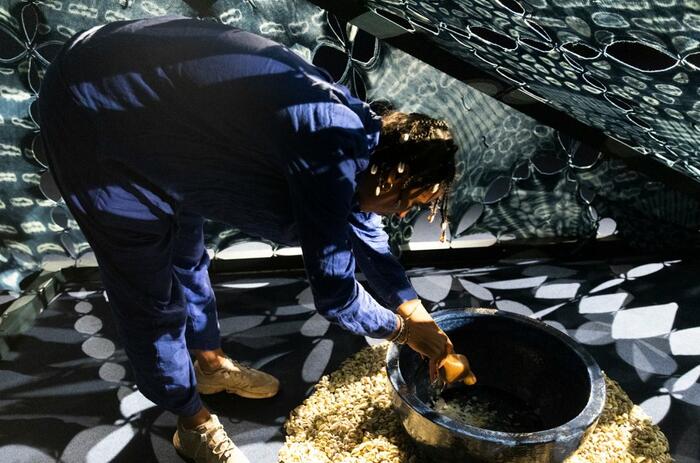
Nebulosa de la calabaza is the title of the first solo exhibition presented in Spain by Tabita Rezaire (Paris, France, 1989), an artist living in French Guiana. Renowned for her use of new media and multidisciplinarity to explore the relationship between contemporary worlds transited from technology and their relationship with the most ancestral and spiritual environment, the Guyanese-heritage artist focuses her production on activism from the perspective of denunciation from feminism and decolonization as key points.
DENOUNCEMENT AND ORIGIN IN TABITA REZAIRE
Nebulosa de la calabaza is the title of the first solo exhibition presented in Spain by Tabita Rezaire (Paris, France, 1989), an artist living in French Guiana. Renowned for her use of new media and multidisciplinarity to explore the relationship between contemporary worlds transited from technology and their relationship with the most ancestral and spiritual environment, the Guyanese-heritage artist focuses her production on activism from the perspective of denunciation from feminism and decolonization as key points.
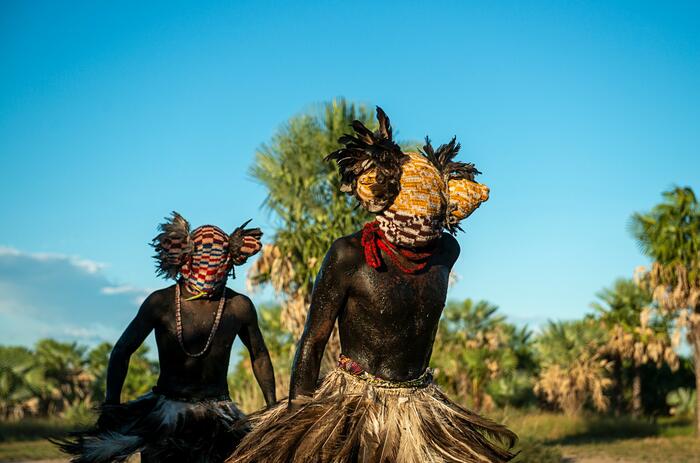
Confines of Paraguay is the initiative of Fernando Allen and Fredi Casco that is part of the Main Section of Pinta BAphoto. It is a project that began with a photographic approach, but expanded into an editorial, audiovisual and documentary archive -along with other activities- related to the works of popular and indigenous artists from Paraguay.
FERNANDO ALLEN AND CONFINES OF PARAGUAY IN PINTA BAphoto 2024
Confines of Paraguay is the initiative of Fernando Allen and Fredi Casco that is part of the Main Section of Pinta BAphoto. It is a project that began with a photographic approach, but expanded into an editorial, audiovisual and documentary archive -along with other activities- related to the works of popular and indigenous artists from Paraguay.
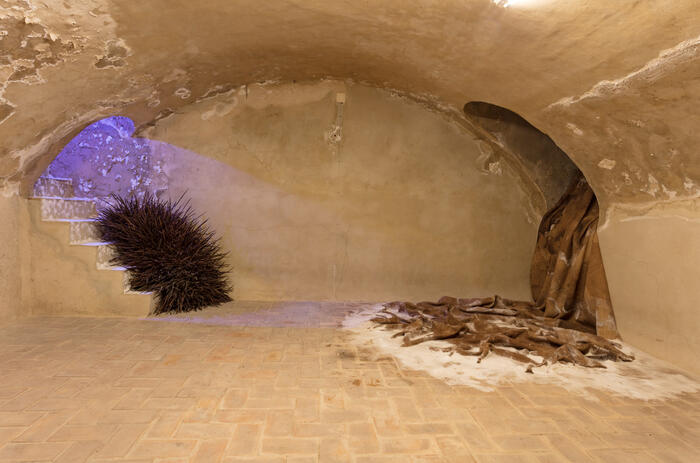
The Andalusian Center for Contemporary Art (CAAC) is showing Continuum or the appearance of the parts and the whole in its recovered space in the cellars of the institution's complex in Seville, an exhibition whose origin is to be sought in Profundis, the proposal that Colombian Delcy Morelos (Tierralta, Colombia, 1967) made for this same center this year and that served as a framework to sublimate, from the analysis, the dialogue beyond the material and the relationship she kept with her collaborators when it came to putting together her recent exhibition.
CONTINUUM: FROM THE DIALOGUE WITH DELCY MORELOS
The Andalusian Center for Contemporary Art (CAAC) is showing Continuum or the appearance of the parts and the whole in its recovered space in the cellars of the institution's complex in Seville, an exhibition whose origin is to be sought in Profundis, the proposal that Colombian Delcy Morelos (Tierralta, Colombia, 1967) made for this same center this year and that served as a framework to sublimate, from the analysis, the dialogue beyond the material and the relationship she kept with her collaborators when it came to putting together her recent exhibition.
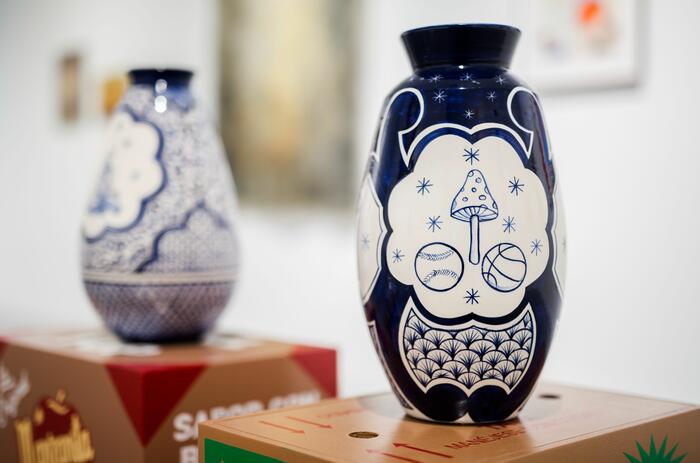
In an art industry that increasingly advocates following the lines established by cultural policies, it is always comforting to return to thesis themes, to environments that draw from social and historiographic sources, of course, but also from myths and a well-understood anthropology. You can go deeper in subtitles and lines or you can put together a skeleton, but the overview can also be a reward these days.
THE FIRE KEEPERS, A PERSPECTIVE ON THE MYTH OF FIRE FROM A MEXICAN CURATORIAL PERSPECTIVE
In an art industry that increasingly advocates following the lines established by cultural policies, it is always comforting to return to thesis themes, to environments that draw from social and historiographic sources, of course, but also from myths and a well-understood anthropology. You can go deeper in subtitles and lines or you can put together a skeleton, but the overview can also be a reward these days.

Based on the biologicist theories on territoriality and the relationships derived from living beings with their immediate environment, the Angeles Baños gallery from Badajoz proposes an exhibition project to three Latin American artists so that, through their experiences and their personal vision, they can materialize and express those feelings of territoriality, and always from the parallelism of the human being with the rest of living beings.
THE TERRITORIAL BY THREE LATIN AMERICAN ARTISTS AT ÁNGELES BAÑOS
Based on the biologicist theories on territoriality and the relationships derived from living beings with their immediate environment, the Angeles Baños gallery from Badajoz proposes an exhibition project to three Latin American artists so that, through their experiences and their personal vision, they can materialize and express those feelings of territoriality, and always from the parallelism of the human being with the rest of living beings.
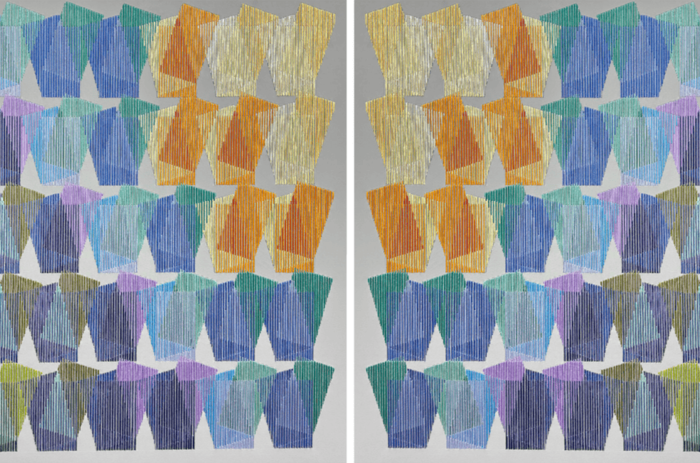
Isabella Despujols (Barquisemeto, Venezuela, 1994), Venezuelan artist based in Brazil, uses her artistic references for the realization of her latest series of works, a set made this year where textiles and embroidery are especially relevant, as well as the formal fact that they reflect. In them is palpable the conversation that he intends to maintain with those styles and languages that were fundamental in the countries to which he circumscribes his personal experience.
DESPUJOLS' EMBROIDERED GEOMETRY AT LLAMAZARES
Isabella Despujols (Barquisemeto, Venezuela, 1994), Venezuelan artist based in Brazil, uses her artistic references for the realization of her latest series of works, a set made this year where textiles and embroidery are especially relevant, as well as the formal fact that they reflect. In them is palpable the conversation that he intends to maintain with those styles and languages that were fundamental in the countries to which he circumscribes his personal experience.
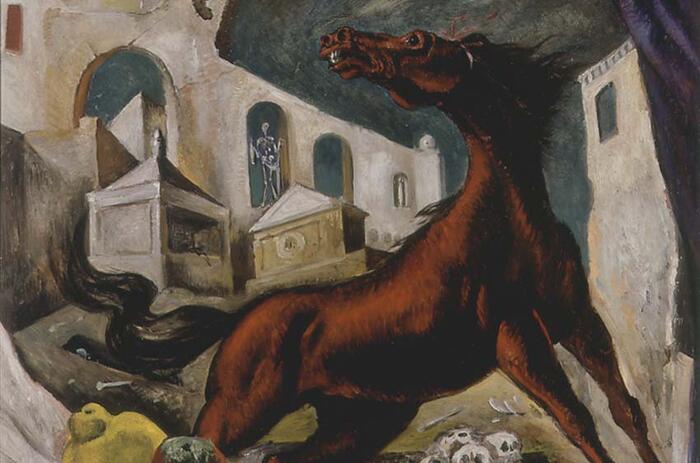
Fundación Casa de Mexico in Spain hosts the exhibition Modern Art of Mexico, with funds from the Blaisten Collection and curated by Daniel Garza Usabiaga, which takes an interesting look at the country's 20th century production through the eyes of Margarita Nelken (Madrid, Spain, 1894-Mexico City, Mexico, 1968).
MEXICAN MODERN ART ACCORDING TO NELKEN AND THE BLAISTEN COLLECTION
Fundación Casa de Mexico in Spain hosts the exhibition Modern Art of Mexico, with funds from the Blaisten Collection and curated by Daniel Garza Usabiaga, which takes an interesting look at the country's 20th century production through the eyes of Margarita Nelken (Madrid, Spain, 1894-Mexico City, Mexico, 1968).
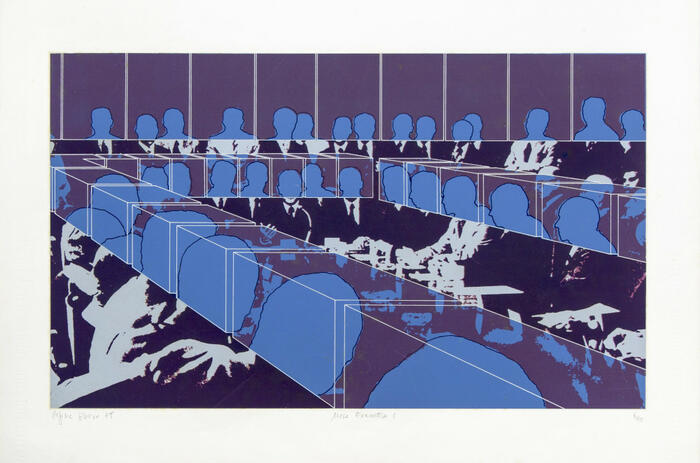
Barcelona's Center of Image La Virreina (La Virreina Centre de la Imatge) is dedicating an extensive exhibition to Regina Silveira (Porto Alegre, Brazil, 1939), one of the multimedia artists and key figures of Latin American conceptual art. Within the exhibition line of the center, which advocates the exploration of the aesthetic and ideological languages of images, this show curated by Isabella Lenzi covers a wide range of the Brazilian artist's research, experimentation and artistic production, particularly that developed with technical reproduction techniques and the circulation of images.
REGINA SILVEIRA'S DESTRUCTION OF POWER
Barcelona's Center of Image La Virreina (La Virreina Centre de la Imatge) is dedicating an extensive exhibition to Regina Silveira (Porto Alegre, Brazil, 1939), one of the multimedia artists and key figures of Latin American conceptual art. Within the exhibition line of the center, which advocates the exploration of the aesthetic and ideological languages of images, this show curated by Isabella Lenzi covers a wide range of the Brazilian artist's research, experimentation and artistic production, particularly that developed with technical reproduction techniques and the circulation of images.

Sol Calero (Caracas, Venezuela, 1982) uses the guanabana, a fruit endemic to Central America and the Caribbean, to symbolically instrumentalize the creation of a representation of the feelings of belonging, home, everyday life and stereotypes through the wide conquest of the spaces of the Museo Centro de Arte Dos de Mayo, transformed for the occasion into visual and popular references of a well-known and recognized Latin America.
IDENTITY AND HOME – ACCORDING TO SOL CALERO IN THE CA2M MUSEUM
Sol Calero (Caracas, Venezuela, 1982) uses the guanabana, a fruit endemic to Central America and the Caribbean, to symbolically instrumentalize the creation of a representation of the feelings of belonging, home, everyday life and stereotypes through the wide conquest of the spaces of the Museo Centro de Arte Dos de Mayo, transformed for the occasion into visual and popular references of a well-known and recognized Latin America.

Nebulosa de la calabaza is the title of the first solo exhibition presented in Spain by Tabita Rezaire (Paris, France, 1989), an artist living in French Guiana. Renowned for her use of new media and multidisciplinarity to explore the relationship between contemporary worlds transited from technology and their relationship with the most ancestral and spiritual environment, the Guyanese-heritage artist focuses her production on activism from the perspective of denunciation from feminism and decolonization as key points.
DENOUNCEMENT AND ORIGIN IN TABITA REZAIRE
Nebulosa de la calabaza is the title of the first solo exhibition presented in Spain by Tabita Rezaire (Paris, France, 1989), an artist living in French Guiana. Renowned for her use of new media and multidisciplinarity to explore the relationship between contemporary worlds transited from technology and their relationship with the most ancestral and spiritual environment, the Guyanese-heritage artist focuses her production on activism from the perspective of denunciation from feminism and decolonization as key points.

Confines of Paraguay is the initiative of Fernando Allen and Fredi Casco that is part of the Main Section of Pinta BAphoto. It is a project that began with a photographic approach, but expanded into an editorial, audiovisual and documentary archive -along with other activities- related to the works of popular and indigenous artists from Paraguay.
FERNANDO ALLEN AND CONFINES OF PARAGUAY IN PINTA BAphoto 2024
Confines of Paraguay is the initiative of Fernando Allen and Fredi Casco that is part of the Main Section of Pinta BAphoto. It is a project that began with a photographic approach, but expanded into an editorial, audiovisual and documentary archive -along with other activities- related to the works of popular and indigenous artists from Paraguay.

The Andalusian Center for Contemporary Art (CAAC) is showing Continuum or the appearance of the parts and the whole in its recovered space in the cellars of the institution's complex in Seville, an exhibition whose origin is to be sought in Profundis, the proposal that Colombian Delcy Morelos (Tierralta, Colombia, 1967) made for this same center this year and that served as a framework to sublimate, from the analysis, the dialogue beyond the material and the relationship she kept with her collaborators when it came to putting together her recent exhibition.
CONTINUUM: FROM THE DIALOGUE WITH DELCY MORELOS
The Andalusian Center for Contemporary Art (CAAC) is showing Continuum or the appearance of the parts and the whole in its recovered space in the cellars of the institution's complex in Seville, an exhibition whose origin is to be sought in Profundis, the proposal that Colombian Delcy Morelos (Tierralta, Colombia, 1967) made for this same center this year and that served as a framework to sublimate, from the analysis, the dialogue beyond the material and the relationship she kept with her collaborators when it came to putting together her recent exhibition.

In an art industry that increasingly advocates following the lines established by cultural policies, it is always comforting to return to thesis themes, to environments that draw from social and historiographic sources, of course, but also from myths and a well-understood anthropology. You can go deeper in subtitles and lines or you can put together a skeleton, but the overview can also be a reward these days.
THE FIRE KEEPERS, A PERSPECTIVE ON THE MYTH OF FIRE FROM A MEXICAN CURATORIAL PERSPECTIVE
In an art industry that increasingly advocates following the lines established by cultural policies, it is always comforting to return to thesis themes, to environments that draw from social and historiographic sources, of course, but also from myths and a well-understood anthropology. You can go deeper in subtitles and lines or you can put together a skeleton, but the overview can also be a reward these days.

Based on the biologicist theories on territoriality and the relationships derived from living beings with their immediate environment, the Angeles Baños gallery from Badajoz proposes an exhibition project to three Latin American artists so that, through their experiences and their personal vision, they can materialize and express those feelings of territoriality, and always from the parallelism of the human being with the rest of living beings.
THE TERRITORIAL BY THREE LATIN AMERICAN ARTISTS AT ÁNGELES BAÑOS
Based on the biologicist theories on territoriality and the relationships derived from living beings with their immediate environment, the Angeles Baños gallery from Badajoz proposes an exhibition project to three Latin American artists so that, through their experiences and their personal vision, they can materialize and express those feelings of territoriality, and always from the parallelism of the human being with the rest of living beings.

Isabella Despujols (Barquisemeto, Venezuela, 1994), Venezuelan artist based in Brazil, uses her artistic references for the realization of her latest series of works, a set made this year where textiles and embroidery are especially relevant, as well as the formal fact that they reflect. In them is palpable the conversation that he intends to maintain with those styles and languages that were fundamental in the countries to which he circumscribes his personal experience.
DESPUJOLS' EMBROIDERED GEOMETRY AT LLAMAZARES
Isabella Despujols (Barquisemeto, Venezuela, 1994), Venezuelan artist based in Brazil, uses her artistic references for the realization of her latest series of works, a set made this year where textiles and embroidery are especially relevant, as well as the formal fact that they reflect. In them is palpable the conversation that he intends to maintain with those styles and languages that were fundamental in the countries to which he circumscribes his personal experience.

Fundación Casa de Mexico in Spain hosts the exhibition Modern Art of Mexico, with funds from the Blaisten Collection and curated by Daniel Garza Usabiaga, which takes an interesting look at the country's 20th century production through the eyes of Margarita Nelken (Madrid, Spain, 1894-Mexico City, Mexico, 1968).
MEXICAN MODERN ART ACCORDING TO NELKEN AND THE BLAISTEN COLLECTION
Fundación Casa de Mexico in Spain hosts the exhibition Modern Art of Mexico, with funds from the Blaisten Collection and curated by Daniel Garza Usabiaga, which takes an interesting look at the country's 20th century production through the eyes of Margarita Nelken (Madrid, Spain, 1894-Mexico City, Mexico, 1968).

Barcelona's Center of Image La Virreina (La Virreina Centre de la Imatge) is dedicating an extensive exhibition to Regina Silveira (Porto Alegre, Brazil, 1939), one of the multimedia artists and key figures of Latin American conceptual art. Within the exhibition line of the center, which advocates the exploration of the aesthetic and ideological languages of images, this show curated by Isabella Lenzi covers a wide range of the Brazilian artist's research, experimentation and artistic production, particularly that developed with technical reproduction techniques and the circulation of images.
REGINA SILVEIRA'S DESTRUCTION OF POWER
Barcelona's Center of Image La Virreina (La Virreina Centre de la Imatge) is dedicating an extensive exhibition to Regina Silveira (Porto Alegre, Brazil, 1939), one of the multimedia artists and key figures of Latin American conceptual art. Within the exhibition line of the center, which advocates the exploration of the aesthetic and ideological languages of images, this show curated by Isabella Lenzi covers a wide range of the Brazilian artist's research, experimentation and artistic production, particularly that developed with technical reproduction techniques and the circulation of images.

Sol Calero (Caracas, Venezuela, 1982) uses the guanabana, a fruit endemic to Central America and the Caribbean, to symbolically instrumentalize the creation of a representation of the feelings of belonging, home, everyday life and stereotypes through the wide conquest of the spaces of the Museo Centro de Arte Dos de Mayo, transformed for the occasion into visual and popular references of a well-known and recognized Latin America.
IDENTITY AND HOME – ACCORDING TO SOL CALERO IN THE CA2M MUSEUM
Sol Calero (Caracas, Venezuela, 1982) uses the guanabana, a fruit endemic to Central America and the Caribbean, to symbolically instrumentalize the creation of a representation of the feelings of belonging, home, everyday life and stereotypes through the wide conquest of the spaces of the Museo Centro de Arte Dos de Mayo, transformed for the occasion into visual and popular references of a well-known and recognized Latin America.

Nebulosa de la calabaza is the title of the first solo exhibition presented in Spain by Tabita Rezaire (Paris, France, 1989), an artist living in French Guiana. Renowned for her use of new media and multidisciplinarity to explore the relationship between contemporary worlds transited from technology and their relationship with the most ancestral and spiritual environment, the Guyanese-heritage artist focuses her production on activism from the perspective of denunciation from feminism and decolonization as key points.
DENOUNCEMENT AND ORIGIN IN TABITA REZAIRE
Nebulosa de la calabaza is the title of the first solo exhibition presented in Spain by Tabita Rezaire (Paris, France, 1989), an artist living in French Guiana. Renowned for her use of new media and multidisciplinarity to explore the relationship between contemporary worlds transited from technology and their relationship with the most ancestral and spiritual environment, the Guyanese-heritage artist focuses her production on activism from the perspective of denunciation from feminism and decolonization as key points.

Confines of Paraguay is the initiative of Fernando Allen and Fredi Casco that is part of the Main Section of Pinta BAphoto. It is a project that began with a photographic approach, but expanded into an editorial, audiovisual and documentary archive -along with other activities- related to the works of popular and indigenous artists from Paraguay.
FERNANDO ALLEN AND CONFINES OF PARAGUAY IN PINTA BAphoto 2024
Confines of Paraguay is the initiative of Fernando Allen and Fredi Casco that is part of the Main Section of Pinta BAphoto. It is a project that began with a photographic approach, but expanded into an editorial, audiovisual and documentary archive -along with other activities- related to the works of popular and indigenous artists from Paraguay.

The Andalusian Center for Contemporary Art (CAAC) is showing Continuum or the appearance of the parts and the whole in its recovered space in the cellars of the institution's complex in Seville, an exhibition whose origin is to be sought in Profundis, the proposal that Colombian Delcy Morelos (Tierralta, Colombia, 1967) made for this same center this year and that served as a framework to sublimate, from the analysis, the dialogue beyond the material and the relationship she kept with her collaborators when it came to putting together her recent exhibition.
CONTINUUM: FROM THE DIALOGUE WITH DELCY MORELOS
The Andalusian Center for Contemporary Art (CAAC) is showing Continuum or the appearance of the parts and the whole in its recovered space in the cellars of the institution's complex in Seville, an exhibition whose origin is to be sought in Profundis, the proposal that Colombian Delcy Morelos (Tierralta, Colombia, 1967) made for this same center this year and that served as a framework to sublimate, from the analysis, the dialogue beyond the material and the relationship she kept with her collaborators when it came to putting together her recent exhibition.

In an art industry that increasingly advocates following the lines established by cultural policies, it is always comforting to return to thesis themes, to environments that draw from social and historiographic sources, of course, but also from myths and a well-understood anthropology. You can go deeper in subtitles and lines or you can put together a skeleton, but the overview can also be a reward these days.
THE FIRE KEEPERS, A PERSPECTIVE ON THE MYTH OF FIRE FROM A MEXICAN CURATORIAL PERSPECTIVE
In an art industry that increasingly advocates following the lines established by cultural policies, it is always comforting to return to thesis themes, to environments that draw from social and historiographic sources, of course, but also from myths and a well-understood anthropology. You can go deeper in subtitles and lines or you can put together a skeleton, but the overview can also be a reward these days.

Based on the biologicist theories on territoriality and the relationships derived from living beings with their immediate environment, the Angeles Baños gallery from Badajoz proposes an exhibition project to three Latin American artists so that, through their experiences and their personal vision, they can materialize and express those feelings of territoriality, and always from the parallelism of the human being with the rest of living beings.
THE TERRITORIAL BY THREE LATIN AMERICAN ARTISTS AT ÁNGELES BAÑOS
Based on the biologicist theories on territoriality and the relationships derived from living beings with their immediate environment, the Angeles Baños gallery from Badajoz proposes an exhibition project to three Latin American artists so that, through their experiences and their personal vision, they can materialize and express those feelings of territoriality, and always from the parallelism of the human being with the rest of living beings.

Isabella Despujols (Barquisemeto, Venezuela, 1994), Venezuelan artist based in Brazil, uses her artistic references for the realization of her latest series of works, a set made this year where textiles and embroidery are especially relevant, as well as the formal fact that they reflect. In them is palpable the conversation that he intends to maintain with those styles and languages that were fundamental in the countries to which he circumscribes his personal experience.
DESPUJOLS' EMBROIDERED GEOMETRY AT LLAMAZARES
Isabella Despujols (Barquisemeto, Venezuela, 1994), Venezuelan artist based in Brazil, uses her artistic references for the realization of her latest series of works, a set made this year where textiles and embroidery are especially relevant, as well as the formal fact that they reflect. In them is palpable the conversation that he intends to maintain with those styles and languages that were fundamental in the countries to which he circumscribes his personal experience.

Fundación Casa de Mexico in Spain hosts the exhibition Modern Art of Mexico, with funds from the Blaisten Collection and curated by Daniel Garza Usabiaga, which takes an interesting look at the country's 20th century production through the eyes of Margarita Nelken (Madrid, Spain, 1894-Mexico City, Mexico, 1968).
MEXICAN MODERN ART ACCORDING TO NELKEN AND THE BLAISTEN COLLECTION
Fundación Casa de Mexico in Spain hosts the exhibition Modern Art of Mexico, with funds from the Blaisten Collection and curated by Daniel Garza Usabiaga, which takes an interesting look at the country's 20th century production through the eyes of Margarita Nelken (Madrid, Spain, 1894-Mexico City, Mexico, 1968).

Barcelona's Center of Image La Virreina (La Virreina Centre de la Imatge) is dedicating an extensive exhibition to Regina Silveira (Porto Alegre, Brazil, 1939), one of the multimedia artists and key figures of Latin American conceptual art. Within the exhibition line of the center, which advocates the exploration of the aesthetic and ideological languages of images, this show curated by Isabella Lenzi covers a wide range of the Brazilian artist's research, experimentation and artistic production, particularly that developed with technical reproduction techniques and the circulation of images.
REGINA SILVEIRA'S DESTRUCTION OF POWER
Barcelona's Center of Image La Virreina (La Virreina Centre de la Imatge) is dedicating an extensive exhibition to Regina Silveira (Porto Alegre, Brazil, 1939), one of the multimedia artists and key figures of Latin American conceptual art. Within the exhibition line of the center, which advocates the exploration of the aesthetic and ideological languages of images, this show curated by Isabella Lenzi covers a wide range of the Brazilian artist's research, experimentation and artistic production, particularly that developed with technical reproduction techniques and the circulation of images.

Sol Calero (Caracas, Venezuela, 1982) uses the guanabana, a fruit endemic to Central America and the Caribbean, to symbolically instrumentalize the creation of a representation of the feelings of belonging, home, everyday life and stereotypes through the wide conquest of the spaces of the Museo Centro de Arte Dos de Mayo, transformed for the occasion into visual and popular references of a well-known and recognized Latin America.
IDENTITY AND HOME – ACCORDING TO SOL CALERO IN THE CA2M MUSEUM
Sol Calero (Caracas, Venezuela, 1982) uses the guanabana, a fruit endemic to Central America and the Caribbean, to symbolically instrumentalize the creation of a representation of the feelings of belonging, home, everyday life and stereotypes through the wide conquest of the spaces of the Museo Centro de Arte Dos de Mayo, transformed for the occasion into visual and popular references of a well-known and recognized Latin America.

Nebulosa de la calabaza is the title of the first solo exhibition presented in Spain by Tabita Rezaire (Paris, France, 1989), an artist living in French Guiana. Renowned for her use of new media and multidisciplinarity to explore the relationship between contemporary worlds transited from technology and their relationship with the most ancestral and spiritual environment, the Guyanese-heritage artist focuses her production on activism from the perspective of denunciation from feminism and decolonization as key points.
DENOUNCEMENT AND ORIGIN IN TABITA REZAIRE
Nebulosa de la calabaza is the title of the first solo exhibition presented in Spain by Tabita Rezaire (Paris, France, 1989), an artist living in French Guiana. Renowned for her use of new media and multidisciplinarity to explore the relationship between contemporary worlds transited from technology and their relationship with the most ancestral and spiritual environment, the Guyanese-heritage artist focuses her production on activism from the perspective of denunciation from feminism and decolonization as key points.

Confines of Paraguay is the initiative of Fernando Allen and Fredi Casco that is part of the Main Section of Pinta BAphoto. It is a project that began with a photographic approach, but expanded into an editorial, audiovisual and documentary archive -along with other activities- related to the works of popular and indigenous artists from Paraguay.
FERNANDO ALLEN AND CONFINES OF PARAGUAY IN PINTA BAphoto 2024
Confines of Paraguay is the initiative of Fernando Allen and Fredi Casco that is part of the Main Section of Pinta BAphoto. It is a project that began with a photographic approach, but expanded into an editorial, audiovisual and documentary archive -along with other activities- related to the works of popular and indigenous artists from Paraguay.

The Andalusian Center for Contemporary Art (CAAC) is showing Continuum or the appearance of the parts and the whole in its recovered space in the cellars of the institution's complex in Seville, an exhibition whose origin is to be sought in Profundis, the proposal that Colombian Delcy Morelos (Tierralta, Colombia, 1967) made for this same center this year and that served as a framework to sublimate, from the analysis, the dialogue beyond the material and the relationship she kept with her collaborators when it came to putting together her recent exhibition.
CONTINUUM: FROM THE DIALOGUE WITH DELCY MORELOS
The Andalusian Center for Contemporary Art (CAAC) is showing Continuum or the appearance of the parts and the whole in its recovered space in the cellars of the institution's complex in Seville, an exhibition whose origin is to be sought in Profundis, the proposal that Colombian Delcy Morelos (Tierralta, Colombia, 1967) made for this same center this year and that served as a framework to sublimate, from the analysis, the dialogue beyond the material and the relationship she kept with her collaborators when it came to putting together her recent exhibition.

In an art industry that increasingly advocates following the lines established by cultural policies, it is always comforting to return to thesis themes, to environments that draw from social and historiographic sources, of course, but also from myths and a well-understood anthropology. You can go deeper in subtitles and lines or you can put together a skeleton, but the overview can also be a reward these days.
THE FIRE KEEPERS, A PERSPECTIVE ON THE MYTH OF FIRE FROM A MEXICAN CURATORIAL PERSPECTIVE
In an art industry that increasingly advocates following the lines established by cultural policies, it is always comforting to return to thesis themes, to environments that draw from social and historiographic sources, of course, but also from myths and a well-understood anthropology. You can go deeper in subtitles and lines or you can put together a skeleton, but the overview can also be a reward these days.

Based on the biologicist theories on territoriality and the relationships derived from living beings with their immediate environment, the Angeles Baños gallery from Badajoz proposes an exhibition project to three Latin American artists so that, through their experiences and their personal vision, they can materialize and express those feelings of territoriality, and always from the parallelism of the human being with the rest of living beings.
THE TERRITORIAL BY THREE LATIN AMERICAN ARTISTS AT ÁNGELES BAÑOS
Based on the biologicist theories on territoriality and the relationships derived from living beings with their immediate environment, the Angeles Baños gallery from Badajoz proposes an exhibition project to three Latin American artists so that, through their experiences and their personal vision, they can materialize and express those feelings of territoriality, and always from the parallelism of the human being with the rest of living beings.

Isabella Despujols (Barquisemeto, Venezuela, 1994), Venezuelan artist based in Brazil, uses her artistic references for the realization of her latest series of works, a set made this year where textiles and embroidery are especially relevant, as well as the formal fact that they reflect. In them is palpable the conversation that he intends to maintain with those styles and languages that were fundamental in the countries to which he circumscribes his personal experience.
DESPUJOLS' EMBROIDERED GEOMETRY AT LLAMAZARES
Isabella Despujols (Barquisemeto, Venezuela, 1994), Venezuelan artist based in Brazil, uses her artistic references for the realization of her latest series of works, a set made this year where textiles and embroidery are especially relevant, as well as the formal fact that they reflect. In them is palpable the conversation that he intends to maintain with those styles and languages that were fundamental in the countries to which he circumscribes his personal experience.

Fundación Casa de Mexico in Spain hosts the exhibition Modern Art of Mexico, with funds from the Blaisten Collection and curated by Daniel Garza Usabiaga, which takes an interesting look at the country's 20th century production through the eyes of Margarita Nelken (Madrid, Spain, 1894-Mexico City, Mexico, 1968).
MEXICAN MODERN ART ACCORDING TO NELKEN AND THE BLAISTEN COLLECTION
Fundación Casa de Mexico in Spain hosts the exhibition Modern Art of Mexico, with funds from the Blaisten Collection and curated by Daniel Garza Usabiaga, which takes an interesting look at the country's 20th century production through the eyes of Margarita Nelken (Madrid, Spain, 1894-Mexico City, Mexico, 1968).

Barcelona's Center of Image La Virreina (La Virreina Centre de la Imatge) is dedicating an extensive exhibition to Regina Silveira (Porto Alegre, Brazil, 1939), one of the multimedia artists and key figures of Latin American conceptual art. Within the exhibition line of the center, which advocates the exploration of the aesthetic and ideological languages of images, this show curated by Isabella Lenzi covers a wide range of the Brazilian artist's research, experimentation and artistic production, particularly that developed with technical reproduction techniques and the circulation of images.
REGINA SILVEIRA'S DESTRUCTION OF POWER
Barcelona's Center of Image La Virreina (La Virreina Centre de la Imatge) is dedicating an extensive exhibition to Regina Silveira (Porto Alegre, Brazil, 1939), one of the multimedia artists and key figures of Latin American conceptual art. Within the exhibition line of the center, which advocates the exploration of the aesthetic and ideological languages of images, this show curated by Isabella Lenzi covers a wide range of the Brazilian artist's research, experimentation and artistic production, particularly that developed with technical reproduction techniques and the circulation of images.

Sol Calero (Caracas, Venezuela, 1982) uses the guanabana, a fruit endemic to Central America and the Caribbean, to symbolically instrumentalize the creation of a representation of the feelings of belonging, home, everyday life and stereotypes through the wide conquest of the spaces of the Museo Centro de Arte Dos de Mayo, transformed for the occasion into visual and popular references of a well-known and recognized Latin America.
IDENTITY AND HOME – ACCORDING TO SOL CALERO IN THE CA2M MUSEUM
Sol Calero (Caracas, Venezuela, 1982) uses the guanabana, a fruit endemic to Central America and the Caribbean, to symbolically instrumentalize the creation of a representation of the feelings of belonging, home, everyday life and stereotypes through the wide conquest of the spaces of the Museo Centro de Arte Dos de Mayo, transformed for the occasion into visual and popular references of a well-known and recognized Latin America.

Nebulosa de la calabaza is the title of the first solo exhibition presented in Spain by Tabita Rezaire (Paris, France, 1989), an artist living in French Guiana. Renowned for her use of new media and multidisciplinarity to explore the relationship between contemporary worlds transited from technology and their relationship with the most ancestral and spiritual environment, the Guyanese-heritage artist focuses her production on activism from the perspective of denunciation from feminism and decolonization as key points.
DENOUNCEMENT AND ORIGIN IN TABITA REZAIRE
Nebulosa de la calabaza is the title of the first solo exhibition presented in Spain by Tabita Rezaire (Paris, France, 1989), an artist living in French Guiana. Renowned for her use of new media and multidisciplinarity to explore the relationship between contemporary worlds transited from technology and their relationship with the most ancestral and spiritual environment, the Guyanese-heritage artist focuses her production on activism from the perspective of denunciation from feminism and decolonization as key points.

Confines of Paraguay is the initiative of Fernando Allen and Fredi Casco that is part of the Main Section of Pinta BAphoto. It is a project that began with a photographic approach, but expanded into an editorial, audiovisual and documentary archive -along with other activities- related to the works of popular and indigenous artists from Paraguay.
FERNANDO ALLEN AND CONFINES OF PARAGUAY IN PINTA BAphoto 2024
Confines of Paraguay is the initiative of Fernando Allen and Fredi Casco that is part of the Main Section of Pinta BAphoto. It is a project that began with a photographic approach, but expanded into an editorial, audiovisual and documentary archive -along with other activities- related to the works of popular and indigenous artists from Paraguay.

The Andalusian Center for Contemporary Art (CAAC) is showing Continuum or the appearance of the parts and the whole in its recovered space in the cellars of the institution's complex in Seville, an exhibition whose origin is to be sought in Profundis, the proposal that Colombian Delcy Morelos (Tierralta, Colombia, 1967) made for this same center this year and that served as a framework to sublimate, from the analysis, the dialogue beyond the material and the relationship she kept with her collaborators when it came to putting together her recent exhibition.
CONTINUUM: FROM THE DIALOGUE WITH DELCY MORELOS
The Andalusian Center for Contemporary Art (CAAC) is showing Continuum or the appearance of the parts and the whole in its recovered space in the cellars of the institution's complex in Seville, an exhibition whose origin is to be sought in Profundis, the proposal that Colombian Delcy Morelos (Tierralta, Colombia, 1967) made for this same center this year and that served as a framework to sublimate, from the analysis, the dialogue beyond the material and the relationship she kept with her collaborators when it came to putting together her recent exhibition.

In an art industry that increasingly advocates following the lines established by cultural policies, it is always comforting to return to thesis themes, to environments that draw from social and historiographic sources, of course, but also from myths and a well-understood anthropology. You can go deeper in subtitles and lines or you can put together a skeleton, but the overview can also be a reward these days.
THE FIRE KEEPERS, A PERSPECTIVE ON THE MYTH OF FIRE FROM A MEXICAN CURATORIAL PERSPECTIVE
In an art industry that increasingly advocates following the lines established by cultural policies, it is always comforting to return to thesis themes, to environments that draw from social and historiographic sources, of course, but also from myths and a well-understood anthropology. You can go deeper in subtitles and lines or you can put together a skeleton, but the overview can also be a reward these days.

Based on the biologicist theories on territoriality and the relationships derived from living beings with their immediate environment, the Angeles Baños gallery from Badajoz proposes an exhibition project to three Latin American artists so that, through their experiences and their personal vision, they can materialize and express those feelings of territoriality, and always from the parallelism of the human being with the rest of living beings.
THE TERRITORIAL BY THREE LATIN AMERICAN ARTISTS AT ÁNGELES BAÑOS
Based on the biologicist theories on territoriality and the relationships derived from living beings with their immediate environment, the Angeles Baños gallery from Badajoz proposes an exhibition project to three Latin American artists so that, through their experiences and their personal vision, they can materialize and express those feelings of territoriality, and always from the parallelism of the human being with the rest of living beings.

Isabella Despujols (Barquisemeto, Venezuela, 1994), Venezuelan artist based in Brazil, uses her artistic references for the realization of her latest series of works, a set made this year where textiles and embroidery are especially relevant, as well as the formal fact that they reflect. In them is palpable the conversation that he intends to maintain with those styles and languages that were fundamental in the countries to which he circumscribes his personal experience.
DESPUJOLS' EMBROIDERED GEOMETRY AT LLAMAZARES
Isabella Despujols (Barquisemeto, Venezuela, 1994), Venezuelan artist based in Brazil, uses her artistic references for the realization of her latest series of works, a set made this year where textiles and embroidery are especially relevant, as well as the formal fact that they reflect. In them is palpable the conversation that he intends to maintain with those styles and languages that were fundamental in the countries to which he circumscribes his personal experience.

Fundación Casa de Mexico in Spain hosts the exhibition Modern Art of Mexico, with funds from the Blaisten Collection and curated by Daniel Garza Usabiaga, which takes an interesting look at the country's 20th century production through the eyes of Margarita Nelken (Madrid, Spain, 1894-Mexico City, Mexico, 1968).
MEXICAN MODERN ART ACCORDING TO NELKEN AND THE BLAISTEN COLLECTION
Fundación Casa de Mexico in Spain hosts the exhibition Modern Art of Mexico, with funds from the Blaisten Collection and curated by Daniel Garza Usabiaga, which takes an interesting look at the country's 20th century production through the eyes of Margarita Nelken (Madrid, Spain, 1894-Mexico City, Mexico, 1968).

Barcelona's Center of Image La Virreina (La Virreina Centre de la Imatge) is dedicating an extensive exhibition to Regina Silveira (Porto Alegre, Brazil, 1939), one of the multimedia artists and key figures of Latin American conceptual art. Within the exhibition line of the center, which advocates the exploration of the aesthetic and ideological languages of images, this show curated by Isabella Lenzi covers a wide range of the Brazilian artist's research, experimentation and artistic production, particularly that developed with technical reproduction techniques and the circulation of images.
REGINA SILVEIRA'S DESTRUCTION OF POWER
Barcelona's Center of Image La Virreina (La Virreina Centre de la Imatge) is dedicating an extensive exhibition to Regina Silveira (Porto Alegre, Brazil, 1939), one of the multimedia artists and key figures of Latin American conceptual art. Within the exhibition line of the center, which advocates the exploration of the aesthetic and ideological languages of images, this show curated by Isabella Lenzi covers a wide range of the Brazilian artist's research, experimentation and artistic production, particularly that developed with technical reproduction techniques and the circulation of images.




